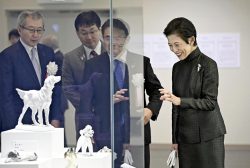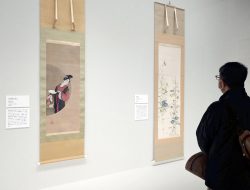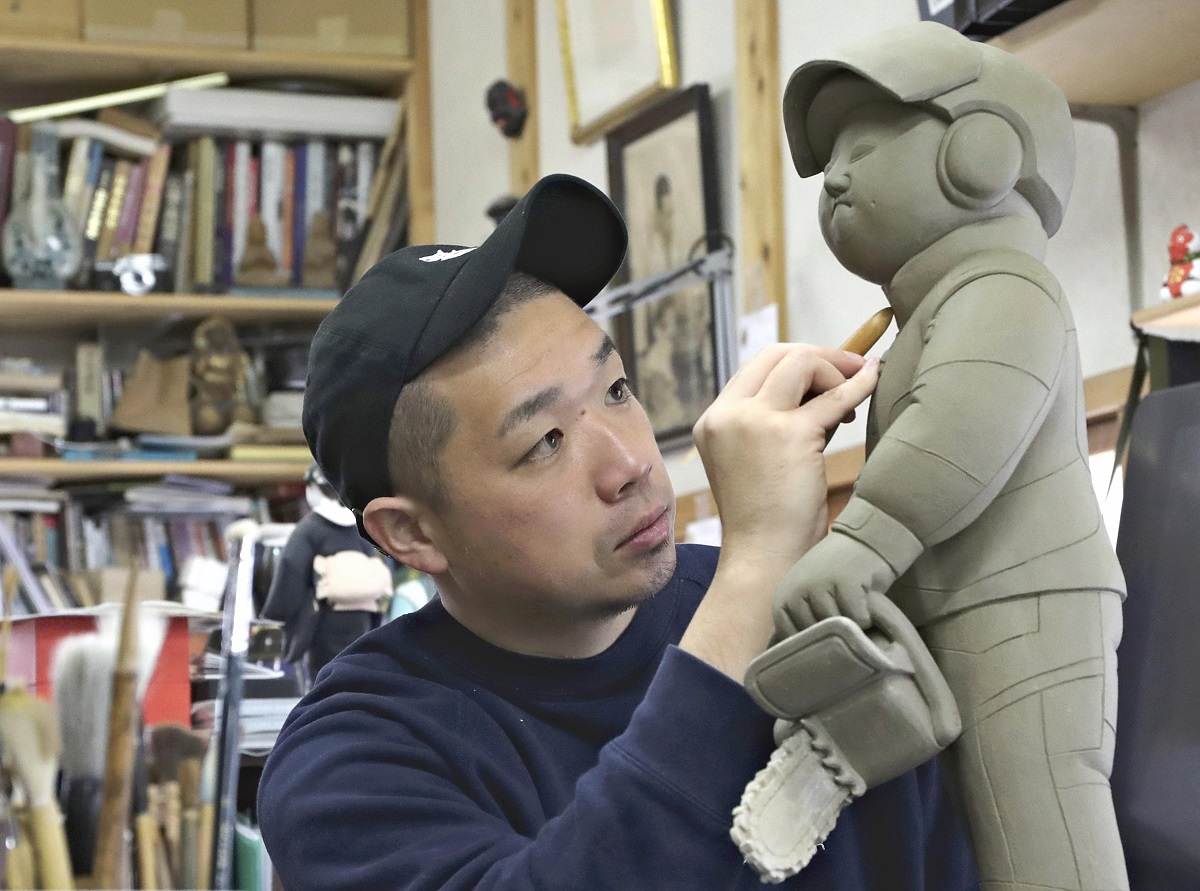
Hiromine Nakamura makes a Hakata doll of a lumberjack with a chainsaw.
10:00 JST, February 25, 2024
FUKUOKA — Doll artist Hiromine Nakamura, 37, has created a small, elaborate statue of pop culture icon Godzilla to mark the character’s 70th anniversary this year. Nakamura is known for bringing modern thoughts and designs to the world of Hakata Ningyo, traditional clay dolls that originated in the Hakata area of Fukuoka.
“I created a statue of Godzilla that I’d want to have myself, that can’t be found anywhere else in the world,” Nakamura said.
Nakamura is a fourth-generation member of the family-run Nakamura Ningyo, a doll-making workshop in Fukuoka that has been in business for over 100 years.
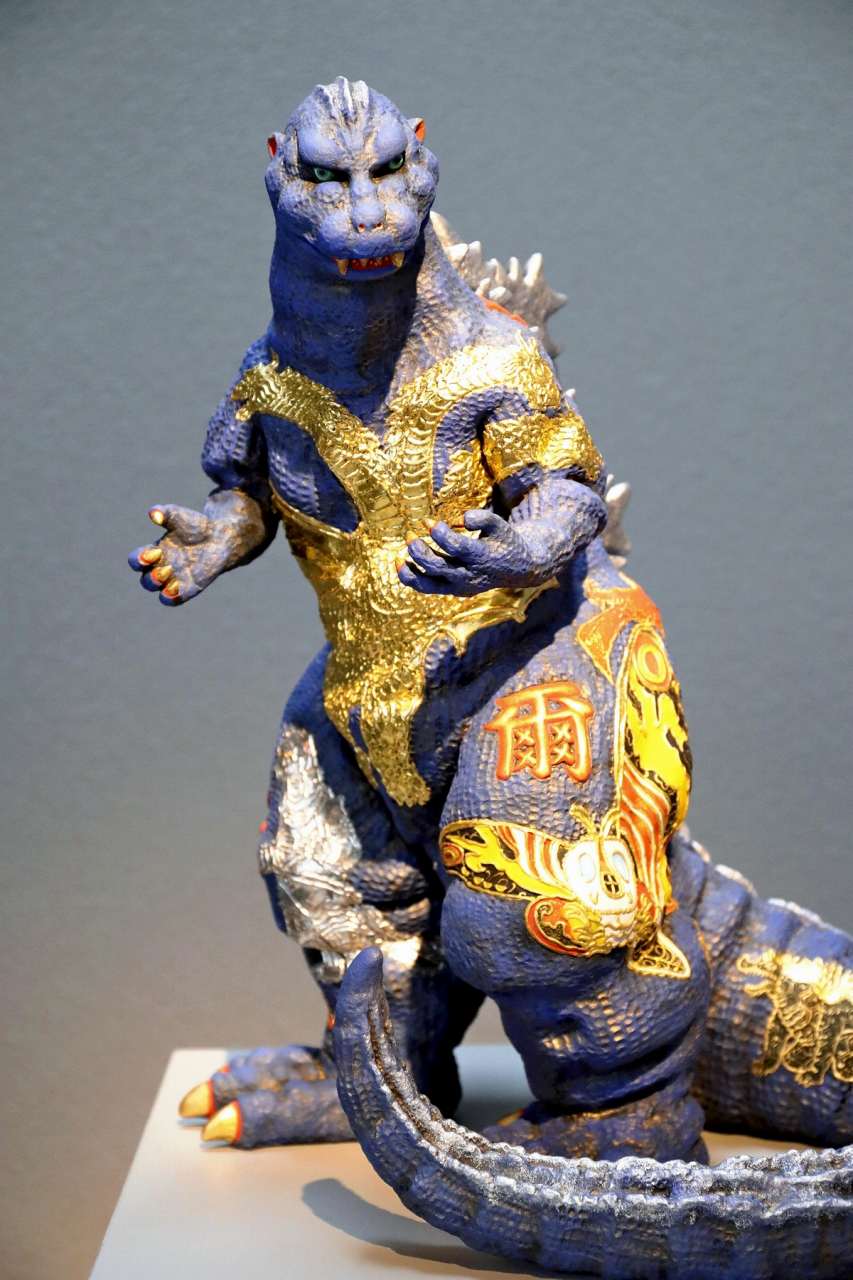
A Godzilla statue created by Nakamura based on the first Godzilla
A record of 70 years
The Godzilla statue has a striking blue color and a heavy, imposing presence that evokes earth-shaking footsteps. Its sharp, shining fangs and claws are powerful, and its body is adorned with the images of 14 monsters that Godzilla has fought, including a golden King Ghidorah on its chest, a richly colored Mothra on its left leg, and a silver Mechagodzilla on its right leg.
Nakamura produced the statue at the request of a local advertising agency to look back on the idolized monster’s 70-year history, which began with the release of its first film in 1954. The statue is about 55 centimeters tall, including its base stand.
Nakamura says he belongs to the generation that watched Heisei-era (1989-2019) Godzilla films. As a child, he went to the cinema whenever a new instalment was released, but his statue was based on the design of the original Godzilla from 70 years ago.
“The wrinkles on its body are amazing,” Nakamura said. “The first Godzilla’s suit [worn by an actor] was the result of trial and error. It’s not graceful, I mean, not symmetric, while today’s Godzilla is more balanced. I feel that the deformed appearance represented Godzilla more as a spiritual being and could be a metaphor for natural disasters and atomic bombings.”
Nakamura studied images of Godzilla and referenced various Godzilla figures from the past to create the clay model of the statue. The process took more than six months.
He divided the model into sections to make molds. A typical Hakata doll consists of three or four molds. By contrast, for his Godzilla statue, Nakamura made 31 molds, the most for any of his works, to elaborately depict the many dorsal fins and the complex shape of Godzilla.
He pressed and applied a layer of clay about seven millimeters thick to each mold. He eventually assembled more than 40 clay parts to form the statue before firing it unglazed and then coloring its surface.
Nakamura says that the most important element of the work is the color of the eyes.
As with his “Green eyes” series, which features such adorable animals as pandas and rhinos, he chose a deep green color to express his reverence for nature.
“I not only wanted to create a Godzilla statue faithfully following the Hakata doll-making technique but also to facilitate a good collaboration between the two,” Nakamura said.
Nakamura decided at an early age to become a doll artist. After studying in the Department of Sculpture at Tokyo University of the Arts and completing a graduate course at the same department in 2011, he began training with his father, Shinkyo, in 2012.
As a student, he focused on the artistic expression of deliberately making new things look old, due to his admiration for old things.
However, after he became a professional doll artist and studied classical works throughout the process of their creation, he felt that creating that style of art was akin to lying.
“So I changed my way of thinking,” he said. “I changed my ideal self-image from a modern doll maker who makes products that look old to a skilled doll maker who traveled through time from the Edo period (1603-1867) to the present day to make something modern.”
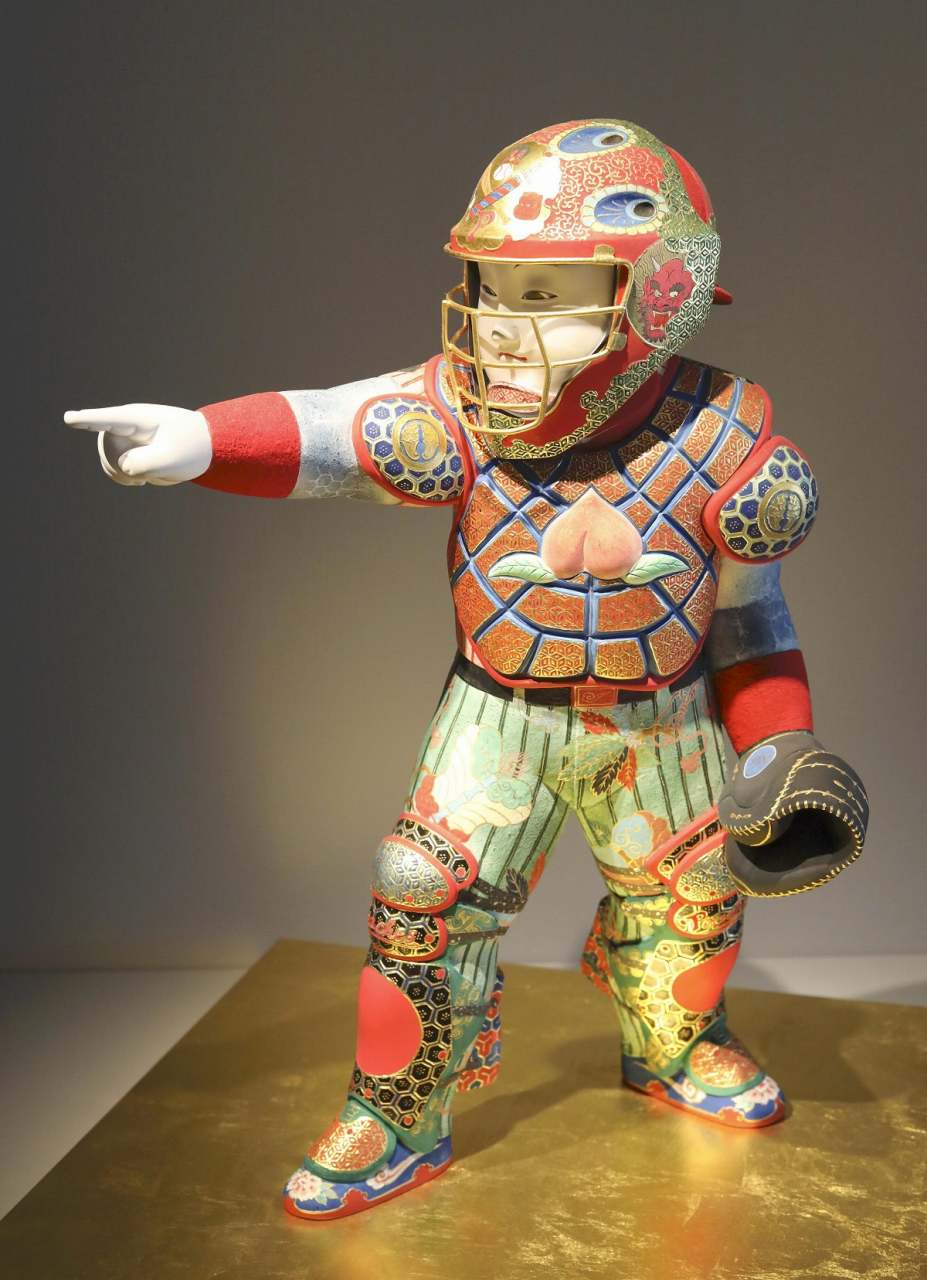
The first doll in Nakamura’s series featuring athletes, which he made for his eldest son to celebrate Children’s Day
Modern heroes
The project which marked a turning point in Nakamura’s career and became his best-known work is his series featuring athletes.
When he was making a doll to celebrate his eldest son’s first Children’s Day, he noticed that Momotaro (Peach Boy), the hero of an old tale, had been a traditional motif to symbolize strength and resilience since ancient times and thought of athletes as a suitable equivalent for the modern age.
Hakata dolls are known for depicting beautiful women and kabuki actors, but Hakata doll makers have actually made all kinds of dolls, Nakamura says.
“Hakata doll makers are a group of highly skilled craftspeople who can satisfy a variety of demands. I want to embody the tradition,” Nakamura said.
His motto as a doll maker is “Dolls give shape to human prayers,” which is a saying that has been passed down in his family from generation to generation.
“I believe that dolls should be able to make the people who see them smile and feel happy, make them feel the impact of their cute appearance. They should inspire positive feelings in people,” Nakamura said. “To preserve the culture, the dolls have to be something that people want to keep by their side. So first and foremost, I want to make dolls that I’d be happy to show to people.”
"Culture" POPULAR ARTICLE
-

Van Cleef & Arpels Dazzles with Art Deco Artisanry at Tokyo Exhibit
-

Disney’s ‘Twisted-Wonderland’ Animated Series Puts Villains in Spotlight: New Show Features School Inspired by Classic Disney Films
-

Japan Plans to Distribute Manga Overseas Via New Platform
-

Ayumi Hamasaki’s Shanghai Concert Canceled Day Before Schedule as Part of Beijing Backlash
-

‘The World Masterpiece Theater Series’ Celebrates 50 Years; Animator Looks Back on Creating Anime Classics
JN ACCESS RANKING
-

Tokyo Economic Security Forum to Hold Inaugural Meeting Amid Tense Global Environment
-

Keidanren Chairman Yoshinobu Tsutsui Visits Kashiwazaki-Kariwa Nuclear Power Plant; Inspects New Emergency Safety System
-

Imports of Rare Earths from China Facing Delays, May Be Caused by Deterioration of Japan-China Relations
-

University of Tokyo Professor Discusses Japanese Economic Security in Interview Ahead of Forum
-

Japan Pulls out of Vietnam Nuclear Project, Complicating Hanoi’s Power Plans



